How to choose the right welding helmet?
How to choose a welding helmet?
A welding helmet is the first piece of welding kit you should invest in after buying the welding machine itself. While all PPE is essential for keeping safe while welding, a welding helmet protects one of your most important assets - your eyes. Welding without adequate eye protection - or any protection at all - causes inflammation of the cornea; the clear outer layer at the front of the eye - the window of the eye, essentially.
In the industry, it is commonly known as ‘arc eye’ or ‘welders flash’. Damage to the cornea occurs when it is exposed to too much ultraviolet light, often from direct sunlight or an arc weld. It can affect how light is focused on the back of the eye. Without the right eye protection, welding can cause eye problems, including:
- Sensitivity to light
- Pain or pressure in the eyes
- Excessive eye watering
- Tearing of the membranes surrounding the eye
- A feeling of gritty eyes
These symptoms won’t show until a few hours after exposure, so you won't know straight away if you’re suffering from arc eye. The distance, duration and angle at which the ultraviolet light enters the eye can all affect the severity of welding flash eye injury, so it is essential to see your doctor if you are experiencing any symptoms.
Arc eye treatment is usually treated with dilating eye drops and sometimes a padded dressing to give the eye chance to rest and recover. If you do not get arc eye treated, you run a higher risk of developing eye infections which, in serious cases, can contribute to varying degrees of vision loss. Long term exposure to UV light from any source can cause permanent damage like cataracts, which can also lead to a loss of vision.
That’s why the correct welding helmet is the most important piece of welding PPE you can invest in. The choice of welding helmets on the market can be overwhelming, especially if you’re new to the trade.
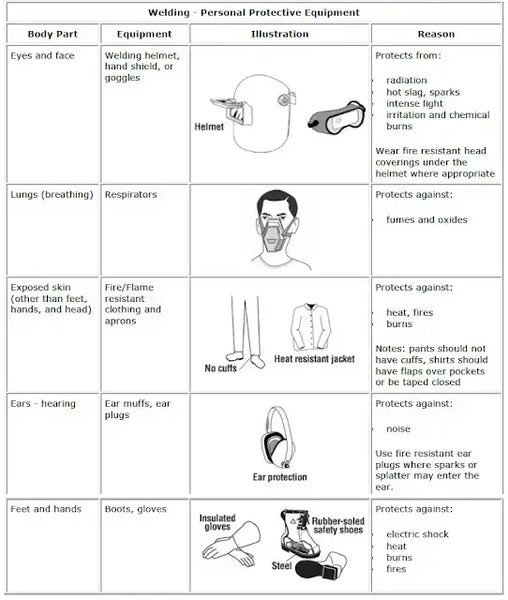
Our welding helmet guide covers everything you need to know about:
- The different types of welding helmets
- Key features to look for (including grinding)
- Technical terms and what they mean
- Choosing the right welding helmet for your specific needs
Different types of Welding Helmets
Solar powered welding helmets
Solar powered welding helmets use a battery to get the helmet started, then solar power will keep it going. If you’re going to be mainly welding outside, a solar-powered helmet could be a good option for you. The only thing to remember is that the helmet will need recharging after every weld so you’ll need somewhere you can leave it outside to soak up the rays. Otherwise when you next come to weld you’ll be faced with an empty battery!
EH-091XL Solar Powered Auto-Darkening Welding Helmet
Many solar-powered welding helmets also include the auto-darkening features explained below.
Auto-darkening helmets
An auto-darkening helmet adjusts to the light, automatically darkening when the arc is struck and becoming lighter when it ends. There are two different types of auto-darkening welding helmet: fixed shade and variable shade.
LYG-W700A Auto Darkening Welding Helmet
A fixed shade auto-darkening welding helmet automatically darkens to a fixed shade, usually shade #10. These are usually cheaper than variable shade helmets and are well worth considering if you work with the same material using the same welding process.
Variable shade auto-darkening welding helmets give you the option to select the darkness of the shade, making them more versatile for use in different welding processes and indoor / outdoor environments. If you’ll be grinding too, be sure to check the welding helmet has a grinding function to prevent the sparks from triggering the auto-darkening tint.
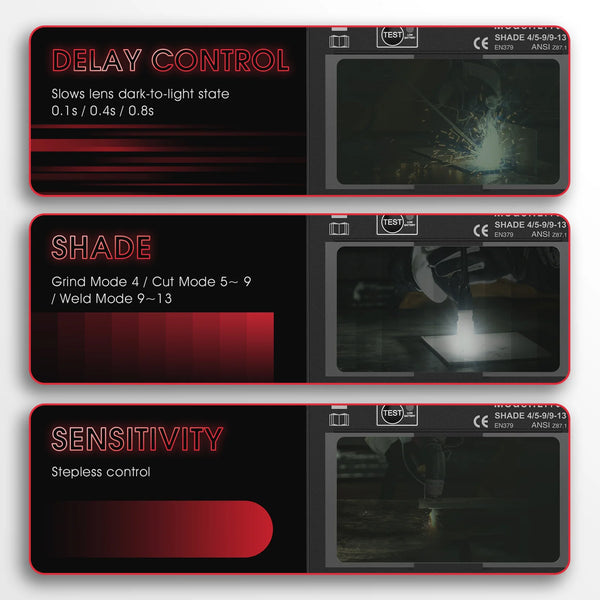
Shades for various welding applications
If you’ll be working on a variety of materials and using different welding processes, a variable auto-darkening welding helmet gives you the flexibility to adjust the shade to your needs, protecting your eyes from ultraviolet light.
At YesWelder we use the German industrial standard to classify light filtering levels: DIN. The DIN number indicates how much light filtration the lens offers. The higher the number, the darker the shade will be. For example a DIN shade 3 lets 14% of light through, while DIN shade 4 only allows 5%. Consider the darkness of your environment before choosing the right DIN as you need to be comfortable enough to see your work area properly.

Auto-darkening welding helmets usually have a passive DIN of 3 or 4 - enough light to set up your work without the need to remove your hood. As you can see on the video, there can be an issue of everything having a green-yellow tint when viewing through a welding lens. That’s where True Colour technology is another important consideration. We’ll talk more about that in a moment.
When the arc is struck, a variable auto-darkening welding helmet will darken to a DIN shade selected by you. Most helmets have a dark DIN range between 9 and 13 to protect your eyes from the arc. Considering an arc is brighter than the sun and incredibly concentrated, it’s no surprise that DIN 13 only lets through 0.00072% of light!
Is it dark enough?
If you can ever see spots in your vision after a weld, choose a darker shade next time. It’s essential to protect your eyes while welding as long term damage can cause vision loss.
The most important thing to remember is the ideal setting: it should be just light enough to see what you need to see but dark enough to prevent eye fatigue.
How to test an auto-darkening welding helmet
Auto-darkening welding helmets should include a self-test button to check that the ADF is working. You should always test your helmet before use - even though the test itself only checks that the battery and ADF is working. It is not a check for an auto-darkening response. To check that, Welditu has a great trick:
“The helmet sensors trigger off IR from the welding arc. An ordinary television remote control emits an IR signal that will also trigger the helmet’s sensors. This handy trick can also test how well the sensors pick up signals from side-to-side, or above and below your mask. Good information to know when working around other welders.”

The number of sensors that control the auto-darkening function can vary. Most helmets range from 2 sensors for hobbyists, to 4 sensors that are better suited to professionals.
True Colour Technology & Optical Clarity
True Colour is an optic technology that provides a clearer view of the weld area, including the arc, puddle and workpiece. It is a modern development that helps to improve productivity and accuracy while reducing mistakes.
Optical clarity indicates how clear and sharp vision is through the lens in both the light and dark state.
Through the lens it can be difficult to differentiate between red and orange, potentially compromising welds and likely giving you a headache in the process. True Colour technology provides an enhanced view of the colours of the weld, allowing welders to see the finer details and produce better quality welds without straining the eyes.
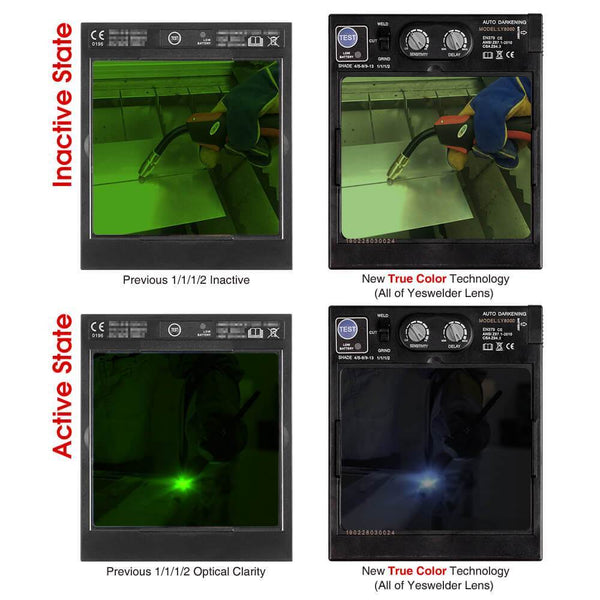
It also assists with training - True Colour technology and an optical clarity allows the operator to see weld defects and potentially prevent any mistakes from occurring.
Viewing area
Welding helmets come with a range of different viewing area sizes and generally in two different styles: a single viewing pane at the front, or panoramic view with additional side windows.
When choosing a welding helmet, consider the angles which you need to see. If you’re a hobbyist or in the shop, you’ll probably be fine with a single viewing pane at the front. If you’re doing fabrication or out-of-position work, a panoramic viewing area gives you greater visibility of the workpiece.
For most welders a large viewing area is preferable as it gives you a wider view of the arc, puddle and workpiece. However, a smaller viewing area provides more focus, which could be beneficial for TIG welders.
LYG-M800HP-A Large View Auto Darkening Welding Helmet
The size of the viewing area affects the weight of the helmet. A larger viewing area = a heavier helmet.
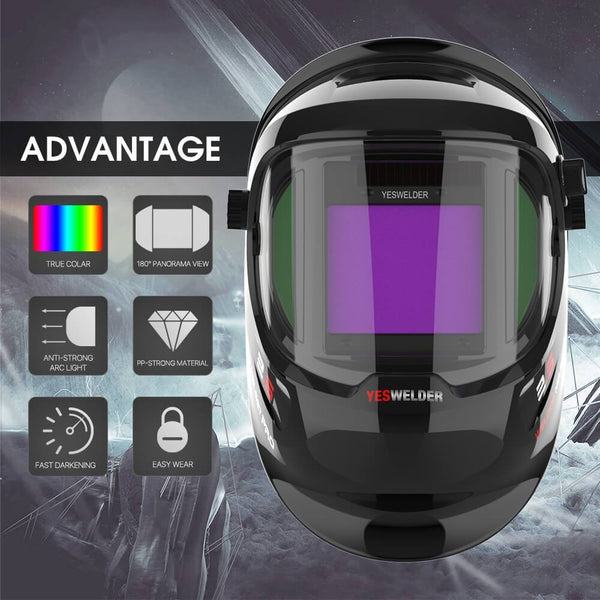
Panoramic view
Welding helmets with a panoramic view have small viewing windows at the side of the helmet to provide a panoramic, all-round view. Panoramic view welding helmets are ideal if you’re welding anywhere ‘out of the shop’ where you’ll be working at different angles. The wider field of vision gives you greater visibility of the workpiece and helps you foresee and prevent problems.
LYG-19800GK-SM Sam Customize Graphic Panoramic View Auto-Darkening Welding Helmet
Be aware that the side windows of panoramic welding helmets may not be auto-darkening. Always check the features of the helmet before purchasing.
LYG-Q800D Panoramic View Auto Darkening Welding Helmet
Comfort & Fit
If your welding helmet isn’t comfortable it will quite literally do your head in. Your full attention needs to be on the weld, not on that irritating ‘digging in’ feeling or worse, worrying that your helmet will slip. Safety is of utmost important while welding and your helmet needs to fit comfortably and securely, otherwise it is not protecting you properly.
Consider the weight of the welding helmet before you buy it. A heavy helmet can cause strain on the neck and head if it’s used for longer periods of time. Modern welding helmets are built from lightweight, durable materials that have somewhat alleviated this concern, though it is still worth considering before buying a welding helmet.
The headgear should spread the weight of the helmet evenly across the head to prevent muscle strain and headaches. It should protect you from the heat emitted from the weld, as well as sparks and other external forces.
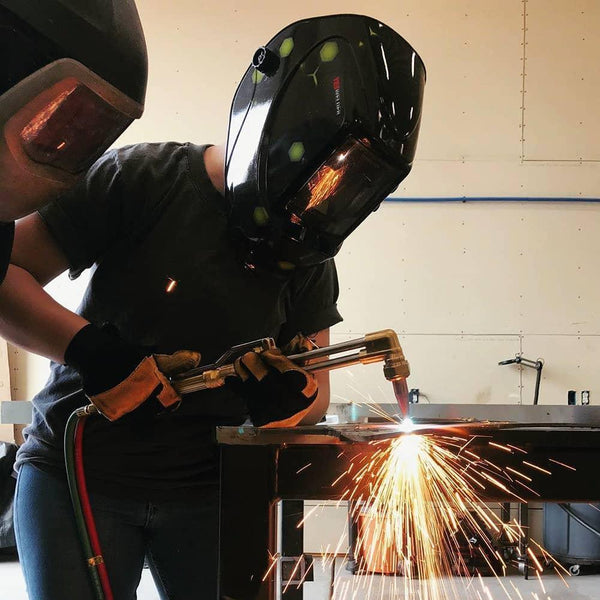
Key points for choosing a welding helmet
- It needs to provide the functions you need. Be it auto-darkening or a wide lens, the welding helmet you choose needs to make welding a comfortable and effective experience.
- It needs to make you productive. If you can’t see your weld properly, you’re more likely to make mistakes which is any welder’s worst nightmare. Fancy starting the weld again because your helmet didn’t work properly? No thanks!
- It should suit your budget. At YesWelder it’s our mission to provide quality welding helmets at an affordable price and according to our customers we do a pretty good job!
- Always read the reviews, especially if you’re new to the industry. Most welders are happy to share their experiences and you can pick up great nuggets of information from them.
- It should suit your type of welding. Whether you’re a hobbyist doing odd welds in the garage or a professional working in and out of the shop, your welding helmet needs to provide for you and most importantly, protect you.

If you’re still unsure about which welding helmet is right for you, head on over to the YesWelder Facebook community page or this guide where an active community of welders will be more than happy to help.




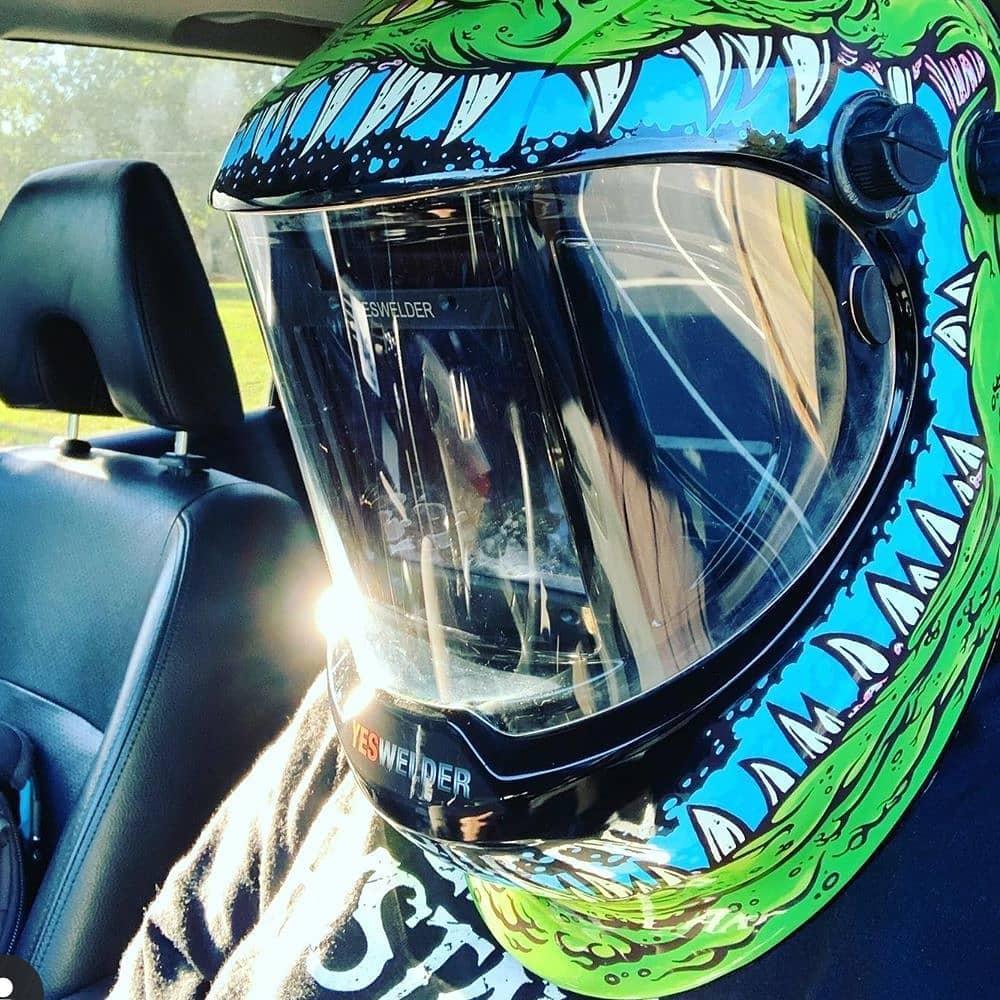

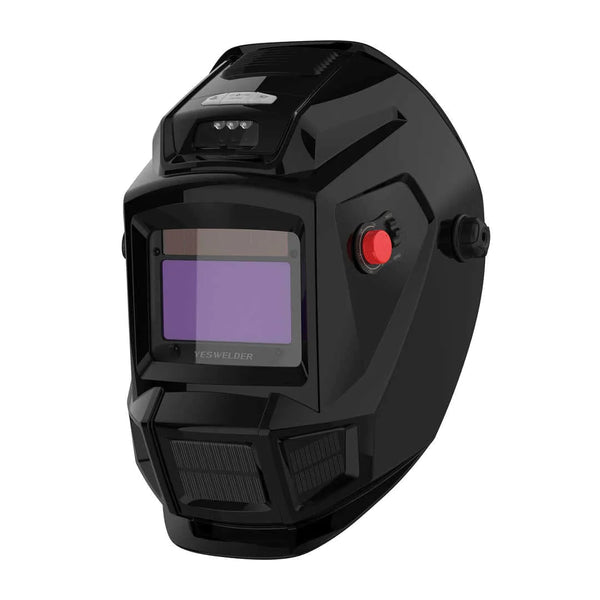


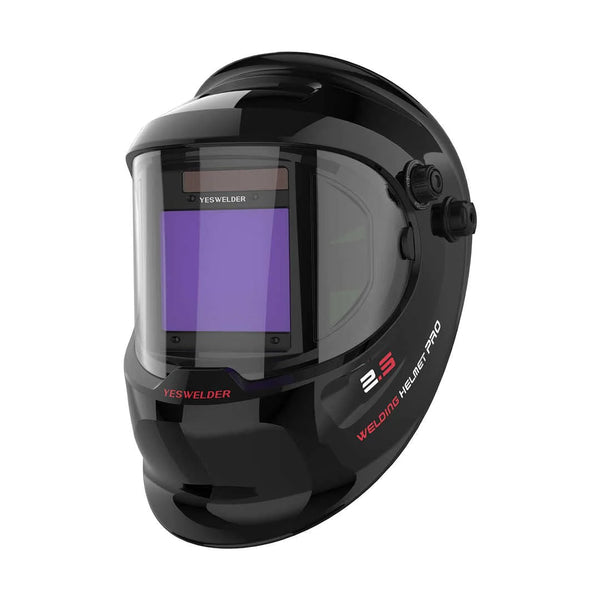


Thank you for the amazing feedback, Connor! We’re very glad to know that you love your YesWelder helmet. :) And thank you for spreading your positive experience, we appreciate this a lot.
As a seasoned welder, I recently upgraded to an auto-darkening helmet, and I must say it has revolutionized my welding experience, and it has exceeded my expectations in terms of functionality, comfort, and overall performance. I would recommend it to everyone!
<https://www.hampdon.com.au/safety/welding/helmets/auto-darkening/>
My brother needs to buy a new welding helmet. I appreciate you mentioning the importance of considering comfort in a helmet. I’ll make sure he finds a helmet that is comfortable for him to wear. https://cmrfabrications.com/products/
Very informative.
Lincoln KP3775-1 Electric Welding Lens is awesome. I uses this lens for tig welding ranging from 30 amps to 140 and it’s all works the same no difference. It’s great for stick welding. You can see your root breaking down the walls. Your hot and fill pass as well as the cap. This lens is great for carbon steel and stainless steel. I’ve had this lens for about three months and dropped my hood multiple times. The dam thing held up. I’m very impressed but not surprised Lincoln makes some of the best products in the industry.
Leave a comment